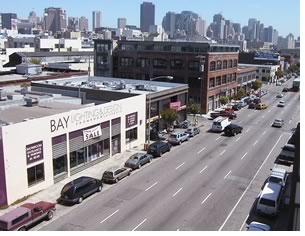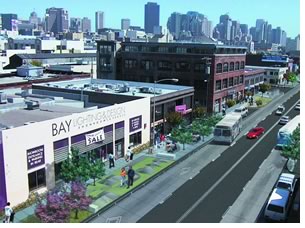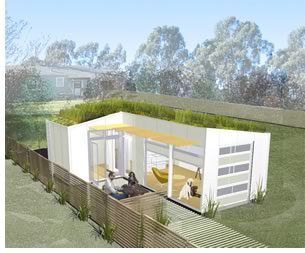

08/2005
Public Architecture’s founder will use year to evaluate future course of the nonprofit firm
 The Harvard Graduate
School of Design recently announced that architect John Peterson, principal
of San Francisco-based Peterson Architects and chair of the nonprofit
firm Public Architecture, has been selected as a Loeb Fellow for the
2005–06 academic year. Established in 1970 and named for Harvard alumnus
John L. Loeb, the annual fellowship offers 10 post-professional candidates
the opportunity for independent study at Harvard with the goal of “nurturing
the leadership potential of the most promising men and women in design
and other professions related to the built and natural environment.” Peterson’s
fellowship will focus on the strategic organizational development of
Public Architecture.
The Harvard Graduate
School of Design recently announced that architect John Peterson, principal
of San Francisco-based Peterson Architects and chair of the nonprofit
firm Public Architecture, has been selected as a Loeb Fellow for the
2005–06 academic year. Established in 1970 and named for Harvard alumnus
John L. Loeb, the annual fellowship offers 10 post-professional candidates
the opportunity for independent study at Harvard with the goal of “nurturing
the leadership potential of the most promising men and women in design
and other professions related to the built and natural environment.” Peterson’s
fellowship will focus on the strategic organizational development of
Public Architecture.
From residential design to design for the public good
Peterson Architects, founded in 1993, has evolved from a residential
firm into a “design-intensive practice, enriched by the contributions
of a diverse group of professionals with expertise in architecture,
landscape architecture, education, publishing, and law.” In 2002,
Peterson established Public Architecture, a nonprofit firm that seeks
out pro bono projects to serve the public interest. “Rather than
waiting for commissions that represent well-understood needs and desires,
Public Architecture takes a leadership role, identifying important
problems of wide relevance that require innovative research and design,
in circumstances where both client and financing must be imagined in
new ways,” says Peterson.
 The relationship between Peterson Architects and Public Architecture
as defined by Peterson is an “informal” one. “We act
as host and incubator for Public Architecture,” he says. “We
share office space and staff as needed, but it’s very much a one-way
relationship.” Peterson Architects also pays the staff’s
salaries. Other donors include the National Endowment for the Arts, the
Boston Society of Architects/AIA, Graham Foundation for Advanced Studies
in the Fine Arts, the LEF Foundation, and Benjamin Moore Paints.
The relationship between Peterson Architects and Public Architecture
as defined by Peterson is an “informal” one. “We act
as host and incubator for Public Architecture,” he says. “We
share office space and staff as needed, but it’s very much a one-way
relationship.” Peterson Architects also pays the staff’s
salaries. Other donors include the National Endowment for the Arts, the
Boston Society of Architects/AIA, Graham Foundation for Advanced Studies
in the Fine Arts, the LEF Foundation, and Benjamin Moore Paints.
To establish a baseline professional standard and engage more architects in providing pro bono services, Public Architecture launched the One Percent Solution initiative, which challenges architects to contribute one percent of working hours to providing their professional services pro bono. Calculated at 40 hours per week, 52 weeks per year, that amounts to 20 hours annually.
 Barriers to providing pro bono work
Barriers to providing pro bono work
Peterson notes that the barriers to providing architecture services pro
bono are real, but not insurmountable. “There’s a reluctance
to get it involved because it appears to be a financial burden,” he
says. “There’s also exposure to liability and no institutionalized
history of pro bono work in the profession. I believe that we actually
are a very generous profession, but we’re used to doing pro bono
work in small scale. There has been no strategic, thought-through business
strategy to benefit both the community and the firm. I want architects
to be more selfish—that is, more careful, thoughtful, and aggressive
about the way we do pro bono work. We need to demand more business
return.” To achieve a better return on investment, Peterson advocates
better marketing of pro bono projects.
 Another
barrier to pro bono is the time commitment necessary. Although the majority
of firms who have signed on as One Percent Solution Program participants
are small firms, Peterson notes that they didn’t “go out
of their way to get smaller firms intentionally. The small firms just
find it easier to make the commitment. With a five-person firm, that’s
only 100 hours per year of pro bono work. With a 100-person firm, it’s
2,000 hours. The numbers look scary to a big firm, but really it’s
just a matter of getting everyone on board because it’s still only
20 hours per person,” emphasizes Peterson.
Another
barrier to pro bono is the time commitment necessary. Although the majority
of firms who have signed on as One Percent Solution Program participants
are small firms, Peterson notes that they didn’t “go out
of their way to get smaller firms intentionally. The small firms just
find it easier to make the commitment. With a five-person firm, that’s
only 100 hours per year of pro bono work. With a 100-person firm, it’s
2,000 hours. The numbers look scary to a big firm, but really it’s
just a matter of getting everyone on board because it’s still only
20 hours per person,” emphasizes Peterson.
Peterson acknowledges that sometimes an architect can be more generous than intended on a pro bono project, but he notes that it’s usually because the architect is deeply committed to doing a good job and seeing the project through, regardless of how long it takes. However, to manage pro bono projects, he recommends that architects exercise careful project management as they would with any other design job. He suggests giving pro bono clients a budget of design time. Each month, send the client an invoice recording the number of hours worked on the project and the remaining time allotted. That way, when the pro bono hours are nearing completion, the architect and client together can decide if work will continue on a paid or pro bono basis, or with another designer.
 The year ahead
The year ahead
Peterson is looking forward to spending his Loeb Fellowship thinking
about the organizational development of Public Architecture. “It’s
a good time to be thoughtful about the future,” he says. “The
types of projects that we’ve taken on to date have been prototypical
by their nature.” Projects undertaken by Public Architecture
include the ScrapHouse, a temporary demonstration home built entirely
of salvaged material next to San Francisco City Hall; a 500-square-foot,
single-level accessory-dwelling unit; a day laborer center where immigrant
laborers can meet and look for work; and a project to preserve public
open space in the South of Market area (SoMA) of San Francisco.
“It will be necessary to take the time to look at 3, 5, 20 years down the road and think about Public Architecture’s strategic course,” says Peterson. “We’re at the right size to determine how we define ourselves and think about our project profile. Is it the right move to focus our work more narrowly or remain eclectic? I believe that Public Architecture will become a ubiquitous organization in the profession. We want to be wise about who we are and where we’ll be.”
Copyright 2005 The American Institute of Architects.
All rights reserved. Home Page ![]()
![]()
 |
||
Renderings courtesy of Public Architecture.
|
||